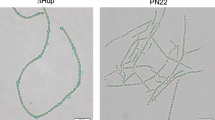Abstract
The genes opcA and zwf are located close to each other in most of cyanobacterial strains and the mutations in the opcA gene were reported to lose most of G6PDH activity. One of the reasons suggested for this loss was the polar effect of the mutation on expression of the zwf gene in the same operon and the other was absence of the OpcA polypeptide necessary for the catalytic activity of G6PDH. Synechocystis sp. PCC 6803 exhibits a gene organisation in which opcA and zwf are far away from each other and is ideal for analysis of an opcA mutation alone. In this study, an opcA single mutant and an opcA-zwf double mutant were constructed and effects of the opcA mutation on G6PDH activity and dark viability were then investigated. Contrary to the previous observations, no negative effect of the mutation on G6PDH activity was found under the optimal substrate concentrations. However, when one of the substrates, G6P or NADP, was reduced gradually, G6PDH activity in the mutant cells decreased faster than the wild types. Our results indicated that an opcA mutation did not affect G6PDH activity severely when zwf and opcA were in different operons. Similarly, dark viability of the opcA single and the zwf-opcA double mutants did not exhibit meaningful difference from the wild type.




Similar content being viewed by others
References
Bradford MM (1976) A rapid and sensitive method for the quantitation of microgram quantities of protein utilizing the principle of protein-dye binding. Anal Biochem 72:248–254
Grant SGN, Jesseet J, Bloomt FR, Hanahan D (1990) Differential plasmid rescue from transgenic mouse DNAs into Escherichia coli methylation-restriction mutants. Proc Natl Acad Sci USA 87:4645–4649
Hagen KD, Meeks JC (2001) The unique cyanobacterial protein OpcA is an allosteric effector of glucose-6-phosphate dehydrogenase in Nostoc punctiforme ATCC 29133. J Biol Chem 276:11477–11486
Kaneko T, Sato S, Kotani H, Tanaka A, Asamizu E, Nakamura Y, Miyajima N, Hirosawa M, Sugiura M, Sasamoto S, Kimura T, Hosouchi T, Matsuno A, Muraki A, Nakazaki N, Naruo K, Okumura S, Shimpo S, Takeuchi C, Wada T, Watanabe A, Yamada M, Yasuda M, Tabata S (1996) Sequence analysis of the genome of the unicellular cyanobacterium Synechocystis sp. strain PCC 6803. II. sequence determination of the entire genome and assignment of potential protein coding regions. DNA Res 3(109–136):185–209
Karakaya H, Ay MT, Ozkul K, Mann NH (2008) A Δzwf (glucose-6-phosphate dehydrogenase) mutant of the cyanobacterium Synechocystis sp. PCC 6803 exhibits unimpaired dark viability. Ann Microbiol 58:281–286
Karakaya H, Mann NH (2008) Mutagenesis of the tal gene-encoding transaldolase in the cyanobacterium Anabaena sp. PCC 7120. Turk J Biol 32:135–141
Kufryk GI, Sachet M, Schmetterer G, Varmaas WFJ (2002) Transformation of the cyanobacterium Synechocystis sp. PCC 6803 as a tool for genetic mapping: optimization of efficiency. FEMS Microbiol Lett 206:215–219
Labarre J, Chauvat F, Thuriaux P (1989) Insertional mutagenesis by random cloning of antibiotic resistance genes into the genome of the cyanobacterium Synechocystis strain PCC6803. J Bacteriol 171:3449–3457
Min H, Golden SS (2000) A new circadian class 2 gene, opcA, whose product is important for reductant production at night in Synechococcus elongatus PCC 7942. J Bacteriol 182(21):6214–6221
Newman J, Karakaya H, Scanlan DJ, Mann NH (1995) A comparison of gene organization in the zwf region of the genomes of the cyanobacteria Synechococcus sp PCC 7942 and Anabaena sp. PCC 7120. FEMS Microbiol Lett 133:187–193
Prentki P, Krisch HM (1984) In vitro insertional mutagenesis with a selectable DNA fragment. Gene 29:303–313
Rippka R (1988) Isolation and purification of cyanobacteria. In: Parker L, Glazer AN (eds) Methods of enzymology, 167 Cyanobacteria. Academic Press Inc, San Diego, pp 3–27
Sambrook J, Russell DW (2001) Molecular cloning a laboratory manual, 3rd edn. Cold Spring Harbor Laboratory Press, Cold Spring Harbor
Scanlan DJ, Sundaram S, Newman J, Mann NH, Carr NG (1995) Notes: characterization of a zwf Mutant of Synechococcus sp. strain PCC 7942. J Bacteriol 177:2550–2553
Schaeffer F, Stanier RY (1978) Glucose-6-phosphate dehydrogenase of Anabaena sp. kinetic and molecular properties. Arch Microbiol 116:9–19
Summers ML, Meeks JC, Chu S, Wolf RE (1995) Nucleotide sequence of an operon in Nostoc sp. strain ATCC 29133 encoding four genes of oxidative pentose phosphate cycle. Plant Physiol 107:267–268
Summers ML, Wallis JG, Campbell EL, Meeks JC (1995) Genetic evidence of a major role for glucose-6-phosphate dehydrogenase in nitrogen fixation and dark growth of the cyanobacterium Nostoc sp. strain ATCC 29133. J Bacteriol 177:6148–6194
Summers ML, Meeks JC (1996) Transcriptional regulation of zwf, encoding glucose-6-phosphate dehydrogenase, from the cyanobacterium Nostoc punctiforme strain ATCC 29133. Mol Biol 22:473–480
Sundaram S, Karakaya H, Scanlan DJ, Mann NH (1998) Multiple oligomeric forms of glucose-6-phosphate dehydrogenase in cyanobacteria and the role of OpcA in the assembly process. Microbiology 144:1549–1556
Zang X, Liu B, Liu S, Arunakumara KKIU, Zhang X (2007) Optimum conditions for transformation of Synechocystis sp. PCC 6803. J Microbiol 45:241–245
Acknowledgments
This project was supported by Ondokuz Mayıs University through the Project BAP F-466.
Author information
Authors and Affiliations
Corresponding author
Rights and permissions
About this article
Cite this article
Özkul, K., Karakaya, H. Characterisation of an opcA Mutant of the Unicellular Cyanobacterium Synechocystis sp. PCC 6803. Curr Microbiol 71, 572–578 (2015). https://doi.org/10.1007/s00284-015-0889-4
Received:
Accepted:
Published:
Issue Date:
DOI: https://doi.org/10.1007/s00284-015-0889-4




